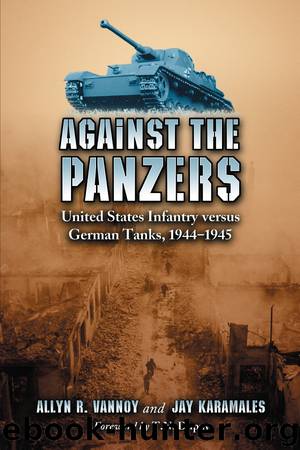Against the Panzers: United States Infantry Versus German Tanks, 1944-1945: A History of Eight Battles Told Through Diaries, Unit Histories by Allyn R. Vannoy & Jay Karamales

Author:Allyn R. Vannoy & Jay Karamales [Vannoy, Allyn R. & Karamales, Jay]
Language: eng
Format: epub
Tags: World War 2, Tactics, Battles
ISBN: 9780786401291
Amazon: 078640129X
Goodreads: 1932666
Publisher: McFarland & Company
Published: 1996-08-01T04:00:00+00:00
4 December
At around 0400 on 4 December, a company-strength force of men was seen approaching the double house from the northwest. It was first thought that the men might be friendly troops, and so some of the GIs called to them. But Lt. Danowski, who was on the roof of the house, recognized them as Germans when they emplaced machine guns in foxholes in the nearby orchard. Danowski ordered all the men to move to higher positions in the double house in order to snipe at the Germans. It was like a “shooting gallery,” with the men picking off the Germans as they became visible. Rifle and hand grenades were employed by the Americans, and the Germans threw some back. Concussion grenades knocked out some of the Third Platoon’s men but otherwise did little harm.
Lt. Danowski, from his rooftop OP, coordinated with Lt. Shipley, the mortar Forward Observer (FO), and brought down the weight of the American mortars. The Germans’ 200 yard frontage was covered with mortar rounds falling at the rate of one every fifteen seconds. From the buildings near the church Lt. Thompson, Weapons Platoon Leader of Company L, laid the fire of his 60mm mortars on the slope of the hill and orchard. The fire of 81mm mortars were laid in close to the house in order to create a barrier against any German landsers who might try to approach the building. The mortar barrage lasted about half an hour. At around 0900 the Germans were seen withdrawing in platoon strength (twenty-five men) to the north. At this time 1st Lt. Dan Dorsey (Company M), who had set up a platoon of heavy machine guns the day before at the Inden factory across the open terrain to the northwest, harassed the withdrawing Germans as they attempted to reach Pier.
The Germans were not able to advance in the face of the fire employed by the Americans in Lucherberg. Just before 1100 their assaults on the double house ceased. At that time Lt. Shipley and Sgt. Shotts went out and picked up four machine guns and three “burp” guns from the dead Germans. A patrol led by Sgt. Cheatham under the cover of BARs from atop the double house traveled in an arc around and through the orchard to the church, flushing remaining Germans out of their holes. The roundup netted twenty prisoners. Many of them were too dazed and shocked to speak coherently while others jumped out of their holes with their hands in the air. As the prisoners were being lined up in the street in front of the church, a sniper fired and killed two American soldiers. The nearby buildings were searched again, but the search failed to turn up the sniper.
Shortly after that, Lt. Sheridan and five men went out, this time circling around the northern edge of town, flushing Germans from the fields and the houses. Germans who tried to resist were killed in their holes. One officer and five men were taken prisoner. This patrol reached the houses near the church by about 1200 and contacted Company L.
Download
This site does not store any files on its server. We only index and link to content provided by other sites. Please contact the content providers to delete copyright contents if any and email us, we'll remove relevant links or contents immediately.
The Vikings: Conquering England, France, and Ireland by Wernick Robert(79184)
Ali Pasha, Lion of Ioannina by Eugenia Russell & Eugenia Russell(39931)
The Vikings: Discoverers of a New World by Wernick Robert(36828)
The Conquerors (The Winning of America Series Book 3) by Eckert Allan W(36709)
Cecilia; Or, Memoirs of an Heiress — Volume 1 by Fanny Burney(32081)
Cecilia; Or, Memoirs of an Heiress — Volume 3 by Fanny Burney(31471)
Cecilia; Or, Memoirs of an Heiress — Volume 2 by Fanny Burney(31425)
Empire of the Sikhs by Patwant Singh(22778)
Hans Sturm: A Soldier's Odyssey on the Eastern Front by Gordon Williamson(18334)
The Secret History by Donna Tartt(18236)
Cat's cradle by Kurt Vonnegut(14785)
Sapiens: A Brief History of Humankind by Yuval Noah Harari(14002)
Pimp by Iceberg Slim(13809)
Talking to Strangers by Malcolm Gladwell(12899)
Norse Mythology by Gaiman Neil(12868)
Leonardo da Vinci by Walter Isaacson(12821)
Underground: A Human History of the Worlds Beneath Our Feet by Will Hunt(11850)
4 3 2 1: A Novel by Paul Auster(11823)
The Radium Girls by Kate Moore(11642)
